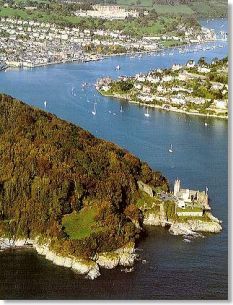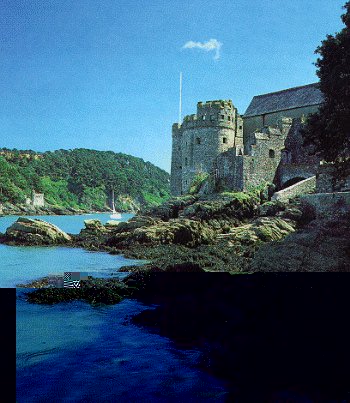Dartmouth
South Devon (UK)
The ancient town and deepwater port of Dartmouth has to be one of Devon's main tourist attractions.

Dartmouth is set in a picture book location, on the picturesque River Dart, with steep wooded hillsides on either side. Dartmouth's main Embankment runs along the length of the town, from the New Quay - built on reclaimed land towards the historic Bayard's Cove. The Embankment provides visitors with a pleasant and relaxing promenade to stroll down - admiring the sights of the busy estuary or to select from the many boat trips that depart from the waters edge.
The main road never reach down into Dartmouth, protecting the character of the town and helping to retain the historic atmosphere of Dartmouth's narrow streets and buildings. Dartmouth's oldest building, The Cherub Pub ( c1380), in Higher Street, and Agincourt House at Lower Ferry, are both examples of 14th century buildings that have survived in the town.
Dartmouth offers the visitor a stunning array of bistros, restaurants, boutiques and specialist shops. All lining Dartmouth's narrow streets with their long flights of winding steps and intriguing medieval buildings.
The Butterwalk, with its timber framed arcade was built in 1635-40. This impressive fašade was damaged by bombs during 1943, but it has now been fully restored.
Historic River Bank and Bayard's Cove
For nearly 1000 years, sailors have set out all over the world from this ancient harbour. The Norman's used Darmouth as a trading port with their homeland across the English Channel - and the Crusaders, led by Richard the Lionheart, set sail from Dartmouth. Both the second and Third crusades assembled and departed from Dartmouth's riverside quays.
The Cobbled Bayards Cove has changed little since 1539. imparting the best impression of just how a cobbled River Bank Quay used to look.
The Cove featured regularly in the Television series The Onedin Line. At the southern end of Bayard's Cove is a small fortification. The artillery fort was built by Dartmouth Corporation in 1510 to provide additional protection to the harbour.
The Pilgrim Fathers
The Pilgrim Fathers, put into Dartmouth's Bayard's Cove, en-route from Southampton to the New World. The pilgrims rested for a time and then set off on their epic journey in the ships - The Mayflower and The Speedwell, on the 20 August 1620.
Some 300 miles west of Land's End, they realsised that the Speedwell was unseaworthy and returned to Plymouth - from where the Mayflower departed alone to complete the crossing to Cape Cod.
Dartmouth Castle
Two impressive Castles have maintained a guard at the mouth of the River Dart for centuries. Dartmouth Castle, built in 1481, featured many state-of-the-art defences. It was the first Castle in the country to be constructed specifically for artillery.
Dartmouth Castle along with Kingswear Castle, on the opposite bank of the river, afforded this deep water anchorage even greater protection by having a heavy chain strung between them in times of war - protecting the ships at anchor and the homes and warehouses of Dartmouth's merchant community.
The Castle maintained its technological advantage for nearly five hundred years. By the Victorian era, Dartmouth Castle was equipped with a Palmerston Gun Battery. This impressive array of guns, could hit a target at a distance of two miles - providing total protection for the River Dart from any enemy shipping.

The Inventor of the Steam Pumping Engine, Thomas Newcomen, was born in Dartmouth in 1663. A working example of one of his engines can be seen in the Engine House.